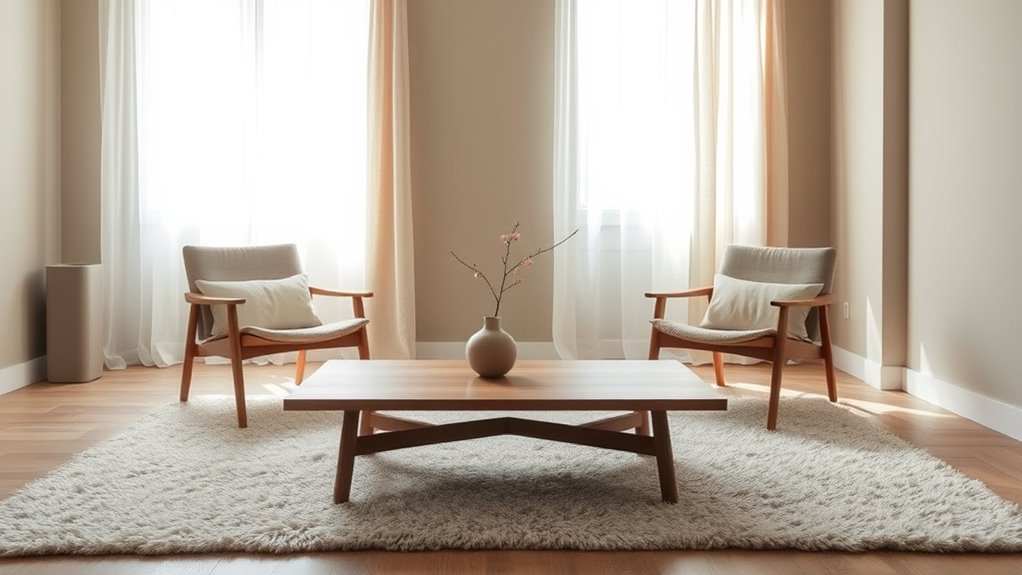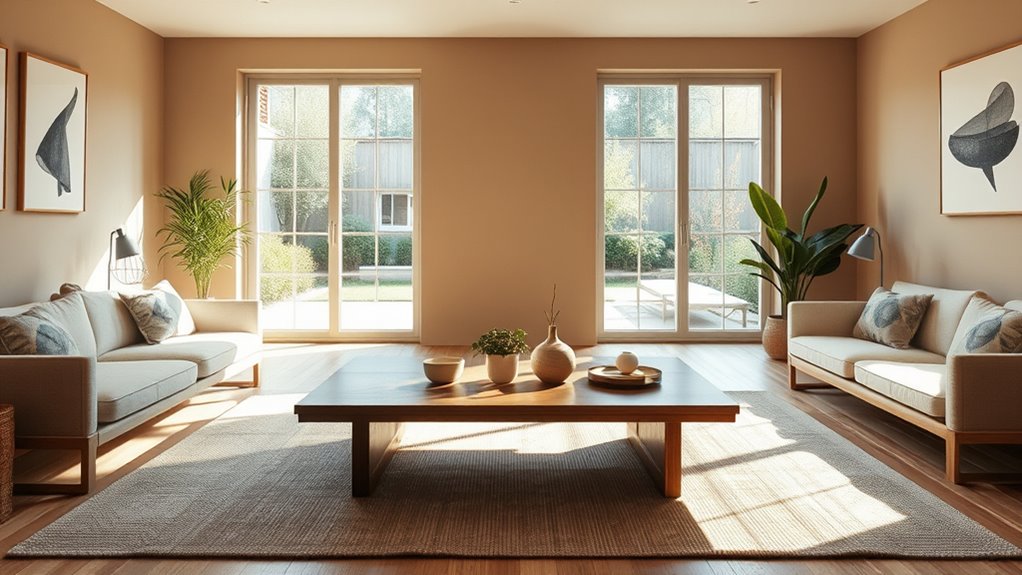Japandi style merges Japanese minimalism with Scandinavian simplicity, creating serene, functional spaces. You’ll love the clean lines and natural materials that invite calmness into your home. With a neutral color palette and low-profile furniture, it emphasizes intentionality and comfort. This aesthetic celebrates craftsmanship and the beauty found in imperfection, fostering a tranquil environment. Plus, it encourages a decluttered, cozy atmosphere that enhances well-being. There’s so much more to discover about incorporating Japandi into your life.
Key Takeaways
- Japandi style combines Japanese minimalism and Scandinavian simplicity for a tranquil living environment.
- It features a neutral color palette with earthy tones and low-profile, multi-functional furniture.
- The design celebrates craftsmanship and embraces wabi-sabi, highlighting beauty in imperfection.
- Japandi promotes decluttering, creating a clutter-free sanctuary that enhances well-being.
- It incorporates hygge elements for comfort, using soft textiles and warm lighting to encourage relaxation.

If you’re looking to create a serene and functional living space, Japandi style might be the perfect fit for you. This design aesthetic beautifully merges Japanese minimalism with Scandinavian simplicity, resulting in a harmonious environment. By focusing on clean lines and natural materials, Japandi brings tranquility into your home while maintaining a functional design that suits modern living.
Imagine stepping into a space where every detail has been thoughtfully considered. The neutral color palette featuring earthy tones and muted shades sets a calming atmosphere, allowing you to breathe and unwind. Low-profile furniture and multi-functional pieces play a pivotal role in this design, reflecting the values of both cultures. You’ll find that every element serves a purpose, promoting intentionality in your decor choices.
Japandi emphasizes craftsmanship and quality, celebrating the beauty in imperfection that comes from the wabi-sabi philosophy. This means that rather than pursuing perfection, you’ll appreciate the unique characteristics of each piece. When you choose furniture or decor, you’re not just selecting items; you’re selecting stories and textures that add depth to your living space.
Embrace the beauty of imperfection in your decor, where each piece tells a unique story and adds depth to your space.
Minimalism is at the core of Japandi style, encouraging you to declutter and simplify. This approach not only brings order to your environment but also allows you to focus on what truly matters. By surrounding yourself with fewer, more meaningful items, your home transforms into a sanctuary. You’ll find that a clutter-free space enhances your well-being, promoting a sense of peace and calm.
Incorporating hygge into your Japandi design adds a layer of comfort and coziness. Think soft textiles, warm lighting, and inviting seating arrangements that draw you in. You want your home to be a place where you can relax, recharge, and enjoy the simple pleasures of life.
As you explore the world of Japandi, keep in mind that it’s about more than just aesthetics. It’s a lifestyle that values intentionality and functional design, allowing you to create an environment that nurtures your spirit. Additionally, consider using scratching posts to redirect your pets’ behavior and maintain the tranquility of your Japandi-inspired home.
Frequently Asked Questions
Is Japandi Still Trendy?
Yes, Japandi is still trendy.
You’ll notice its seamless blend of Japanese minimalism and Scandinavian functionality resonates with today’s design enthusiasts. The focus on natural materials and neutral palettes creates that serene atmosphere many seek in their homes.
Social media platforms consistently showcase Japandi-inspired interiors, reflecting ongoing interest.
Plus, with remote work becoming the norm, creating calming spaces is more essential than ever, solidifying Japandi’s place in contemporary interior design.
What Are the Rules of Japandi Style?
When you dive into Japandi style, focus on a neutral color palette that keeps your space serene.
Prioritize clean lines and uncluttered areas, ensuring each piece has a purpose.
Incorporate natural materials like wood and stone to add texture and connect with nature.
Embrace multi-functional furniture to maximize your space’s versatility, and choose high-quality, handcrafted decor that celebrates simplicity.
These rules will help you create a beautifully balanced environment.
Why Is Japandi so Expensive?
Did you know that handmade furniture can cost up to 30% more than mass-produced items?
Japandi style is often expensive due to its focus on high-quality materials like solid wood and artisanal craftsmanship. Each piece is meticulously designed for durability and functionality, which adds to the cost.
Plus, the limited availability of these unique items drives prices higher, making your investment in Japandi furnishings not just about aesthetics, but also about sustainability and quality.
What Is the Difference Between Wabi-Sabi and Japandi?
Wabi-sabi and Japandi differ in their core philosophies.
When you embrace wabi-sabi, you celebrate imperfections and the beauty of aging, focusing on authenticity.
In contrast, Japandi blends Japanese and Scandinavian styles, emphasizing clean lines, minimalism, and functionality.
While wabi-sabi values asymmetry and natural forms, Japandi seeks a cohesive, elegant aesthetic.
Both promote tranquility, but wabi-sabi leans toward philosophical appreciation, whereas Japandi prioritizes creating serene, practical living spaces.
Conclusion
In the end, embracing Japandi style means embracing simplicity, embracing functionality, and embracing serenity. You’ll find that blending Japanese minimalism with Scandinavian coziness creates a space that feels both calming and inviting. You’ll enjoy clean lines, natural materials, and a thoughtful design that encourages mindfulness. So, whether you’re redecorating or just seeking inspiration, remember: Japandi isn’t just a trend; it’s a lifestyle that celebrates harmony and balance in every corner of your home.









